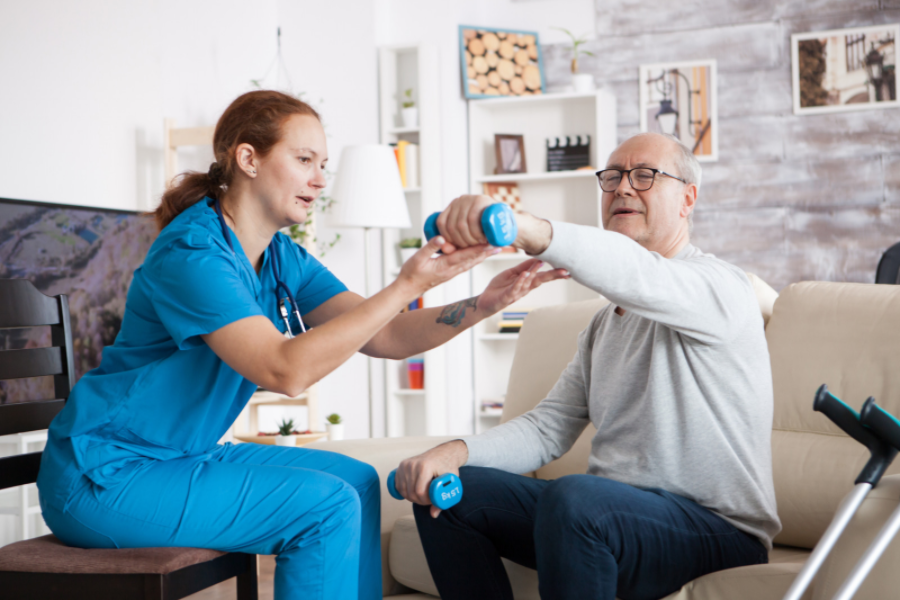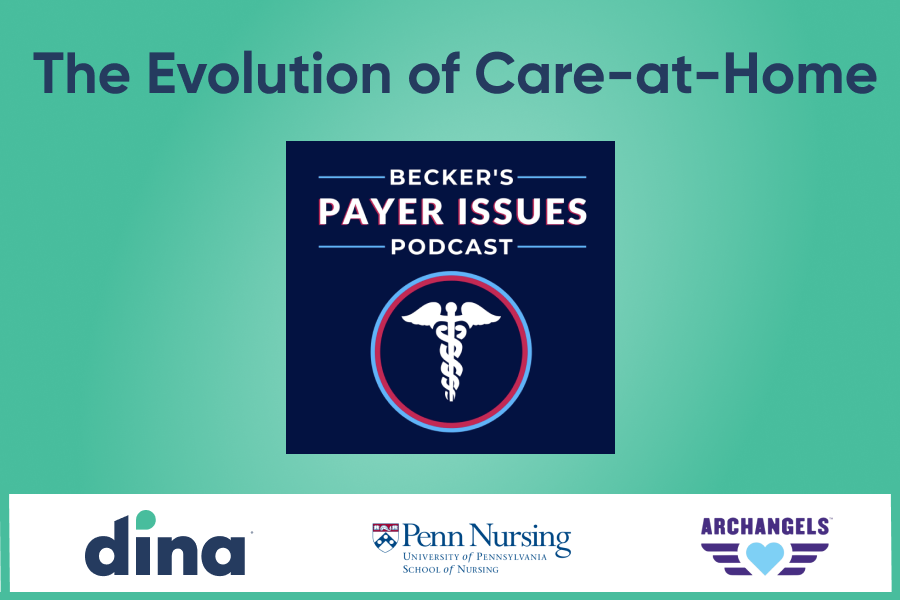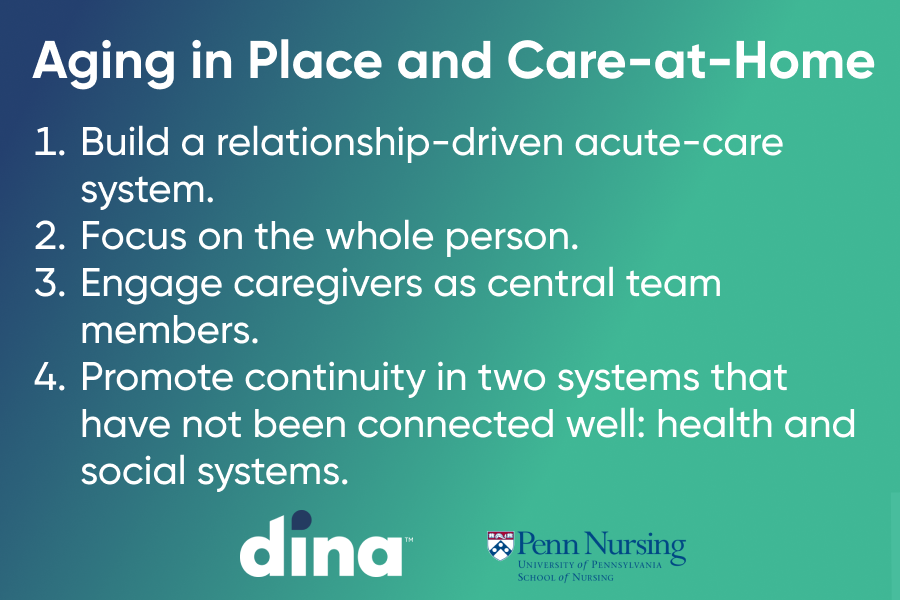
There is a movement underway to shift the care of high-risk, older adults from costly settings such as hospitals and post-acute facilities into their homes and communities.
Findings from several NIH-funded clinical trials reinforce the potential to positively impact outcomes for this population by focusing on care at home, said Mary Naylor, director of the NewCourtland Center for Transitions and Health at the University of Pennsylvania School of Nursing.
 “Leaders in both the public and private sectors need to understand that we need to do something different,” she said. “We need to invest in a care system that anticipates our demographic and economic imperatives: a rapidly growing population of chronically ill and disabled adults, a shrinking caregiver workforce, and rising healthcare costs. At the same time, we have to begin to address the inequities in health outcomes that have been exposed by COVID-19.”
“Leaders in both the public and private sectors need to understand that we need to do something different,” she said. “We need to invest in a care system that anticipates our demographic and economic imperatives: a rapidly growing population of chronically ill and disabled adults, a shrinking caregiver workforce, and rising healthcare costs. At the same time, we have to begin to address the inequities in health outcomes that have been exposed by COVID-19.”
Naylor was part of the Becker’s Payer Issues podcast: “The Evolution of In-Home Care: Leveraging Supplemental Benefits.” Dina CEO Ashish V. Shah led the discussion, which also included Alex Drane, CEO of Archangels. Following is a recap of their conversation.
Shifting Care to the Home
Shah: What do we need at a high level to support aging in place and care-at-home right now?
Naylor: From my perspective, the hallmark of success is enabling all older adults, including disadvantaged subgroups and their caregivers, to achieve high-quality lives. To do this:
- We need an acute care system that is relationship-driven; people have to trust their providers.
- We need a care system that is whole-person-focused. We learned early on that we were not going to have much of an impact without helping people access not just great medical care, but high-quality food, safe housing, and any needed social support.
- We need to engage caregivers as central team members.
- And, finally, we have to think about how to promote continuity in two systems that have not been connected well: health and social systems.

key differentiator. Why have they become so important?
Naylor: Supplemental Benefits have long been offered by Medicare Advantage plans, but have historically been limited to select health services such as vision, hearing, or dental. Since 2018, however, legal and CMS regulatory changes created more flexibility for Medicare Advantage plans to innovate and expand some of these services to improve care and engagement.
What I think is most interesting and exciting is that plans can now offer new services, such as home-based palliative care, adult day care, or caregiver support, which has been shown to be essential to support particularly high-risk or at-risk older adults who are aging in place.
Medicare Advantage plans are now able to offer disease-tailored benefits that are specific to beneficiaries with conditions like heart failure, for example. They can receive disease-targeted services from care managers with specific clinical training. This change is a substantial revision that former uniform requirement prohibited.
Shah: We are now starting to see some other new creative benefits like meal preparation/delivery, personal care, and transportation. I’m fascinated that these benefits have started to showcase some strong outcomes. How do you see this evolving?

While there’s been a significant increase in the number of health plans offering some of these services, there is substantial variation in the services. Many are offering meals and transportation; relatively few to date are offering home-based services, palliative care, or caregiver support. So I think these health plans are on a journey. They are in a test-and-learn environment in the early years of these expanded Supplemental Benefits. And in some cases, they’re going to need a push to really have some of these important opportunities take off.
Shah: It sounds like from your perspective, the current list of Supplemental Benefits, ranging from eye exams to in-home services, is not a static list; it will continue to grow.

The question is: what is the best path to go from here, where are we in this nascent period? There are a number of barriers that need to be addressed such as the lack of connectivity between health and social systems. There are technological limitations, although there are also major advances in addressing those limitations. So I think we can turn these barriers into great opportunities.
Health plans are in a test-and-learn environment. In some cases, they’re going to need a push to really have some of these important (Supplemental Benefits) opportunities take off.
Shah: Something that I think has great potential is supporting personal or family caregivers. Why do caregivers need to be part of this vast portfolio of “extras” or Supplemental Benefits?
Drane: Due to COVID-19, a full 43 percent of adults in the U.S. are in this role of an unpaid caregiver; 23 percent of adults are actually sandwich-generation caregivers. Behind every Medicare Advantage member is an unpaid caregiver. It could be a partner, an adult child, or a neighbor. Addressing the reality of this population that is so foundational to keeping our economy alive is critical. I don’t think you can support the patient and Medicare Advantage member without bringing in the unpaid caregiver.
Shah: That unpaid family caregiver may also have advised that senior on their choice around health insurance and things like Medicare Advantage. If we were to begin to shape a new Supplemental Benefit around this particular area, where do you think the opportunity is to not only help a senior age in place but to support their caregiving community who also needs to remain healthy?
Behind every Medicare Advantage member is an unpaid caregiver. This is where decisions get made.
Drane: We need to start by acknowledging the role that caregivers play in influencing the decisions that the person who is experiencing a chronic illness or end-of-life experience needs to make, but also the impact that it has on those who are around them. This is where decisions are getting made–it’s a vital communication channel within transitions of care. They’re the ones who are going to help this individual make these choices and decide whether they feel good about the benefits that are supporting them in the care of this person. I’m hopeful that benefits will move in this direction and that we’ll start to see resources for these unpaid family caregivers and resources that ultimately help take care of the entire family ecosystem.
Listen to the Becker’s Payer Issues podcast: “The Evolution of In-Home Care: How to Leverage Supplemental Benefits Offerings.”




